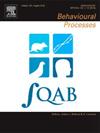饲养密度对斑马鱼在斜坡加迷宫中焦虑行为的影响
IF 1.3
4区 生物学
Q4 BEHAVIORAL SCIENCES
引用次数: 0
摘要
实验动物的种群密度是维持生物健康的关键因素。不适当的饲养条件会影响研究结果的有效性和可靠性,使研究之间难以进行比较。在斑马鱼(Danio rerio)等群居物种中,过度拥挤或拥挤不足是一个需要考虑的变量。在本研究中,我们评估了在不同暴露时间内不同密度的饲养对斑马鱼在斜坡加迷宫试验中焦虑反应的影响。研究对象(144 条)按饲养时间(1 天、7 天和 30 天)分为三个大组。每组根据鱼的密度(0.25、0.5、1、2、4、6 条/升,n = 8)分为六个亚组,饲养在一个 4 升的水族箱中。设定饲养条件后,在 PMR 中对每只动物进行单独测试。时间和饲养密度改变了斑马鱼的探索行为。饲养时间的增加减少了斑马鱼在斜臂中的停留时间,饲养 30 天的斑马鱼在斜臂中的停留时间更少。在每升饲养 2 条和 6 条斑马鱼的饲养组中,饲养密度增加了斑马鱼在扁平臂中的停留时间,反之,则减少了斑马鱼在斜坡臂中的探索时间。而隔离则增加了在斜坡臂的探索时间,这表明隔离具有抗焦虑作用。在这项研究中,我们证明了饲养条件可以作为低强度的慢性应激源,在 PMR 方案测试中改变斑马鱼的焦虑行为。本文章由计算机程序翻译,如有差异,请以英文原文为准。
Effects of housing density on anxiety-like behavior of zebrafish in the plus maze with ramp
Population density in experimental animals is a crucial factor in maintaining the wellbeing of the organisms. Inadequate housing conditions can compromise the validity and reliability of research results, making comparisons between studies difficult. In sociable species such as zebrafish (Danio rerio), which are housed in groups, overcrowding or undercrowding represents a variable that needs to be considered. In this study, we evaluated the effects of housing at different densities for different exposure times on the anxiety response measured in the Plus Maze with Ramp test in zebrafish. The subjects (144) were divided into three large groups according to the housing time (1, 7, and 30 days). Each group was divided into six subgroups based on the density of the fish (0.25, 0.5, 1, 2, 4, 6 fish/liter, n = 8) and housed in a 4-liter aquarium. After the housing conditions, each animal was tested individually in the PMR. Time and housing density altered the exploratory behavior of zebrafish. Increased housing time reduced the time spent in the ramp arms, with groups kept for 30 days spending less time in this compartment. Density increased the time spent in the flat arms in groups with 2 and 6 fish/liter and, conversely, reduced the exploration of the ramp arms. Isolation, on the other hand, increased the exploration of the ramp arms, indicating an anxiolytic effect. In this study, we demonstrate that housing conditions can act as low-intensity chronic stressors that alter anxiety-like behavior in zebrafish when tested in the PMR protocol.
求助全文
通过发布文献求助,成功后即可免费获取论文全文。
去求助
来源期刊

Behavioural Processes
生物-动物学
CiteScore
2.70
自引率
7.70%
发文量
144
审稿时长
4-8 weeks
期刊介绍:
Behavioural Processes is dedicated to the publication of high-quality original research on animal behaviour from any theoretical perspective. It welcomes contributions that consider animal behaviour from behavioural analytic, cognitive, ethological, ecological and evolutionary points of view. This list is not intended to be exhaustive, and papers that integrate theory and methodology across disciplines are particularly welcome.
 求助内容:
求助内容: 应助结果提醒方式:
应助结果提醒方式:


